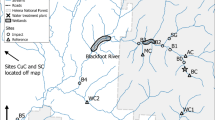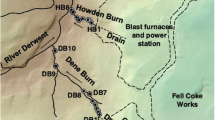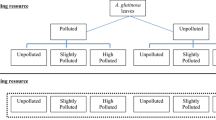Abstract
The fine particle fraction of sediments collected near bulkheads made of chromated copper arsenate (CCA)-treated wood had elevated concentrations of the three chemicals. These decreased with distance from the bulkhead. Although the concentrations in the fine particle fraction of these sediments were quite high, the sediments had less than 1% fine particles, being primarily sand. Concentrations of the three contaminants in benthic organisms adjacent to the bulkhead were also elevated and decreased with distance. However, toxicity tests with the sediments adjacent to the bulkhead did not reveal consistent toxicity, probably because the overall concentration of metals was low. On the other hand, benthic community analysis revealed that there were reduced species richness, total numbers of organisms, and diversity in the sediments adjacent to the bulkheads, compared to reference sediments with lower metal concentrations.
Similar content being viewed by others
References
American Society for Testing and Materials (1990) Standard guide for conducting sediment toxicity tests with marine and estuarine amphipods. E 1367–90. Annual Book of ASTM Standards, Philadelphia, pp 1052–1075
Becker DS, Ginn TC (1990) Effects of sediment holding time on sediment toxicity. Report of PTI Environmental Services Inc for USEPA Region 10 Office of Puget Sound Seattle WA, USEPA 910/9-90-009
Bryan GW, Gibbs P (1983) Heavy metals in the Fal estuary, Cornwall: a study of long-term contamination by mining waste and its effects on estuarine organisms. Mar Biol Assoc UK Occ Publ #2, Plymouth, UK, 112 pp
Chapman PM (1990) The sediment quality triad approach to determining pollution-induced degradation. Sci Total Environ 97/98:815–825
DiToro D, Mahoney J, Hansen D, Scott K, Hicks M, Mayr S, Redmond M (1991) Toxicity of cadmium in sediments: The role of acid volatile sulfide. Environ Toxicol Chem 9:1487–1502
Grassle JP, Grassle JF (1974) Opportunistic life histories and genetic systems in marine benthic polychaetes. J Mar Res 32:253–284
Langston WJ (1980) Arsenic in United Kingdom estuarine sediments and its availability to benthic organisms. J Mar Biol Assoc UK 60:869–881
Langston WJ (1984) Availability of arsenic to estuarine and marine organisms: A field and laboratory investigation. Mar Biol 80:143–154
Lloyd M, Ghelardi RJ (1964) A table for calculating the equitability component of species diversity. J Anim Ecol 33:217–225
Luoma SN (1989) Can we determine the biological availability of sediment-bound trace elements? Hydrobiologia 176/177:379–396
Luoma SN, Davis JA (1983) Requirements for modelling trace metal partitioning in oxidized estuarine sediments. Mar Chem 12:159–181
Riedel GF, Sanders JG, Osman RW (1987) The effect of biological and physical disturbances on the transport of arsenic from contaminated estuarine sediments. Estuar Coast Shelf Sci 25:693–706
Rule JH (1985) Chemical extractions of heavy metals in sediments as related to metal uptake by grass shrimp (Palaemonetes pugio) and clam (Mercenaria mercenaria). Arch Environ Contam Toxicol 14:749–757
Rule JH, Alden III RW (1990) Cadmium bioavailability to three estuarine animals in relation to geochemical fractions of sediments. Arch Environ Contam Toxicol 19:878–885
Rygg B (1985) Effects of sediment copper on benthic fauna. Mar Ecol Prog Ser 25:83–89
Tatem HE, Brandon DL, Lee CR, Jarvis AS, Rhett RG (1991) Effects of storage on sediment toxicity, bioaccumulation potential and chemistry. US Army Corps of Engineers, Waterways Experiment Station Misc Paper EL-91-2, 62 pp
Warner JE, Solomon KR (1990) Acidity as a factor in leaching of copper, chromium, and arsenic from CCA-treated dimension lumber. Environ Toxicol Chem 9:1331–1337
Weis JS, Weis P (1992) Transfer of contaminants from CCA-treated lumber to aquatic biota. J Exp Mar Biol Ecol 161:189–199
—, — (1993) Trophic transfer of contaminants from organisms living by chromated-copper-arsenate (CCA)-treated wood to their predators. J Exp Mar Biol Ecol 168:25–34
Weis P, Weis JS, Coohill L (1991) Toxicity to estuarine organisms of leachates from chromated copper arsenate treated wood. Arch Environ Contam Toxicol 20:188–194
Weis P, Weis JS, Greenberg A, Nosker TJ (1992) Toxicity of construction materials in the marine environment: A comparison of chromated-copper-arsenate-treated wood and recycled plastic. Arch Environ Contam Toxicol 22:99–106
Weis P, Weis JS, Lores E. Uptake of metals from chromated-copper-arsenate (CCA)-treated lumber by epibiota. Mar Pollut Bull (in press)
Weis P, Weis JS, Procter T (1993) Copper, chromium and arsenic in sediments adjacent to wood treated with chromated-copper-arsenate. Estuar Coast Shelf Sci 36:71–79
Author information
Authors and Affiliations
Rights and permissions
About this article
Cite this article
Weis, J.S., Weis, P. Effects of contaminants from chromated copper arsenate-treated lumber on benthos. Arch. Environ. Contam. Toxicol. 26, 103–109 (1994). https://doi.org/10.1007/BF00212800
Received:
Revised:
Issue Date:
DOI: https://doi.org/10.1007/BF00212800




